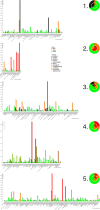The Virtual-Spine Platform-Acquiring, visualizing, and analyzing individual sitting behavior
- PMID: 29897910
- PMCID: PMC5999082
- DOI: 10.1371/journal.pone.0195670
The Virtual-Spine Platform-Acquiring, visualizing, and analyzing individual sitting behavior
Abstract
Back pain is a serious medical problem especially for those people sitting over long periods during their daily work. Here we present a system to help users monitoring and examining their sitting behavior. The Virtual-Spine Platform (VSP) is an integrated system consisting of a real-time body position monitoring module and a data visualization module to provide individualized, immediate, and accurate sitting behavior support. It provides a comprehensive spine movement analysis as well as accumulated data visualization to demonstrate behavior patterns within a certain period. The two modules are discussed in detail focusing on the design of the VSP system with adequate capacity for continuous monitoring and a web-based interactive data analysis method to visualize and compare the sitting behavior of different persons. The data was collected in an experiment with a small group of subjects. Using this method, the behavior of five subjects was evaluated over a working day, enabling inferences and suggestions for sitting improvements. The results from the accumulated data module were used to elucidate the basic function of body position recognition of the VSP. Finally, an expert user study was conducted to evaluate VSP and support future developments.
Conflict of interest statement
The authors have declared that no competing interests exist.
Figures














References
-
- Vos T, Flaxman AD, Naghavi M, Lozano R, Michaud C, Ezzati M, et al. Years lived with disability (YLDs) for 1160 sequelae of 289 diseases and injuries 1990–2010: a systematic analysis for the Global Burden of Disease Study 2010. The Lancet. 2013;380(9859):2163–2196. doi: 10.1016/S0140-6736(12)61729-2 - DOI - PMC - PubMed
-
- Bauman A, Ainsworth BE, Sallis JF, Hagströmer M, Craig CL, Bull FC, et al. The descriptive epidemiology of sitting: a 20-country comparison using the International Physical Activity Questionnaire (IPAQ). American Journal of Preventive Medicine. 2011;41(2):228–235. doi: 10.1016/j.amepre.2011.05.003 - DOI - PubMed
-
- Roffey DM, Wai EK, Bishop P, Kwon BK, Dagenais S. Causal assessment of occupational sitting and low back pain: results of a systematic review. The Spine Journal. 2010;10(3):252–261. doi: 10.1016/j.spinee.2009.12.005 - DOI - PubMed
-
- Brink Y, Louw QA. A systematic review of the relationship between sitting and upper quadrant musculoskeletal pain in children and adolescents. Manual therapy. 2013;18(4):281–288. doi: 10.1016/j.math.2012.11.003 - DOI - PubMed
-
- Cohen D. An objective measure of seat comfort. Aviation, Space, and Environmental Medicine. 1998;69(4):410–414. - PubMed
Publication types
MeSH terms
LinkOut - more resources
Full Text Sources
Other Literature Sources
Medical

